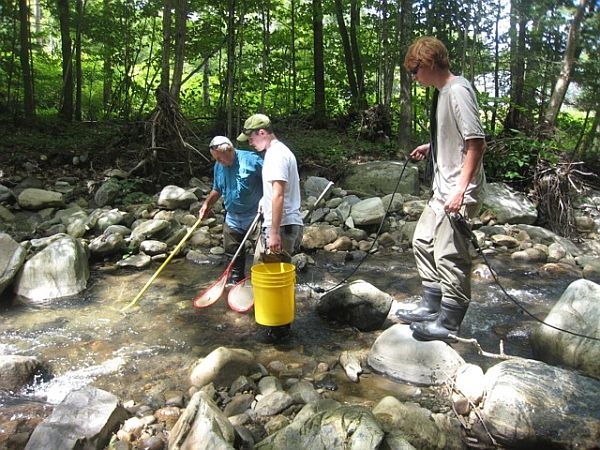
Walk across a Vermont river this summer and you’re likely to find footing on stones that were upstream a year ago. Tropical Storm Irene threw them down river, along with trees and roots, chunks of asphalt, parts of houses.
The flood severely altered the natural world. But in some cases, people did even more damage.
The floodwaters grabbed the landscape pushing and clawing anything in its path. Everything got moved. Even fish.
"They are going to be swimming and looking for places where they can get out of the main flow," explained Fisheries Biologist Kenneth Cox of the Vermont Department of Fish and Wildlife.
"As a result of that a lot of fish are going to die during the event and did die."
Cox says in some stretches of river as many as 60 percent of the fish were lost in reaches pummeled by the flood. But others found shelter under rocks and other natural debris. Those are the survivors that will rebuild fish populations in the next few years.
Cox and two colleagues are wading up a stretch of the South Branch of the Williams River in Chester. They’re running an electric current in the water to stun the fish so they can collect and count them before throwing them back. It doesn’t hurt the fish. The researchers find several juvenile salmon, but the trout are scarce.
"Another salmon," said Cox as he netted a fish.
"Whoa! Nice one! That’s a trout isn’t it? In the bucket."
It’s a beautiful fish. But this is the only brown trout they’ll find in this stretch.
Across the state biologists are counting fish in rivers like this one that were scoured by the flood and in others where humans did the damage. Their goal is to compare fish populations before the storm to after. Cox says a telling case is Bailey Brook in Reading where one section was altered by the flood; another was excavated by people.
"The excavated area had substantially fewer fish in it," said Cox. "And a worse representation of size or age classes than the section that experienced flood damage alone."
In a recent report the Vermont Fish and Wildlife Department estimated, conservatively, that 77 miles of stream were severely damaged by people. But sometimes it was a question of public safety.
Back on August 30th, two days after the flood, Edward Gilbert is sitting inside a big yellow excavator in the Whetstone Brook.
"We’re trying to put the road back is what it is," Gilbert said. "It’s in the river."
Gilbert is trying to repair a stretch of Route 9 in Marlboro that’s destroyed. Gravel and stone are scarce
"We can’t get it out of Brattleboro because the roads are washed out," said Gilbert. "And the trucks are coming so far away that it’s just one every two hours."
At this point even emergency vehicles can’t get through here.
So excavators hauled asphalt and rocks out of streams to rebuild.
But David Deen, a state lawmaker and the River Steward for the Connecticut River Watershed Council says there were other cases where roads did not have to be rebuilt immediately. But rivers were damaged.
"The problem is that they took the rebuilding materials out of the river," said Deen.
Deen is standing on a section of road in Westminster that caved into the Saxtons River during the flood. He says stone, gravel and sand that make up essential habitat for insects and fish were hauled away to repair this road.
"So that that habitat area, that those insects and other forms of aquatic life would use on the bottom of the stream, is gone," said Deen. "At least some significant percentage of it is gone."
Deen points out another stretch of the Saxtons where people dug rocks from the river bottom and built up the stream bank in a effort to prevent flooding. Instead Deen said it cut the river off from the flood plain.
"That is absolutely the wrong thing to be doing relative to making Vermont rivers less flood-prone," said Deen. "What’s happened here has made this river more flood-prone, not necessarily for this reach, but for down stream."
But Deen says there were no laws to stop them
"In an emergency situation there was no guidance so you did what you had to do in order to rebuild roads or other infrastructure. You just did it," recalled Deen. "And in this case it was with the support of the Governor. And it was because there was no guidance. There is now emergency guidance and emergency rules will be in place soon."
Deen was one of the sponsors of a new law, known as Act 138, which sets forth new regulations governing the removal of rocks and trees from rivers or building berms.
Mike Kline, Vermont’s Rivers Program Manager, says the state is in the process now of developing the rules for towns to follow even in the face of a disaster.
But he acknowledged that after Irene, with Tropical Storm Lee bearing down, towns had little choice and with only a few state river engineers, little help.
"When we had the level of wide-spread damage that we had, it just simply was not possible to have the river engineering expertise available to all of the communities that desperately needed it," said Kline.
But what if another flood occurs, one that is as severe as Irene? Will people, faced with danger, act any differently? Even with a new law?
Kline is hopeful they will.
"This is not only about keeping the rivers as healthy as we can, said Kline. "It’s about the future, safety and vulnerability of a community. and how certain actions, while seemingly appropriate at the time, may cause more vulnerability going forward."
Kline says if towns can protect floodplains now the less damage there will be in the next flood, both to people — and to rivers and fish.